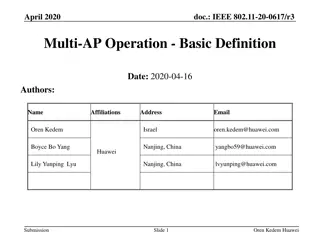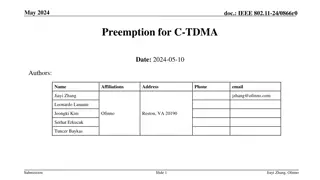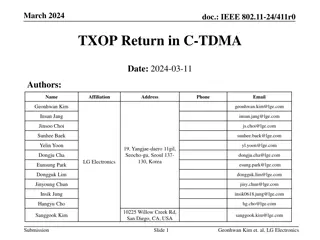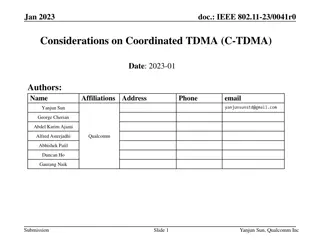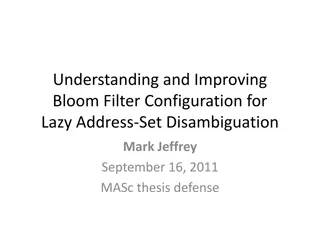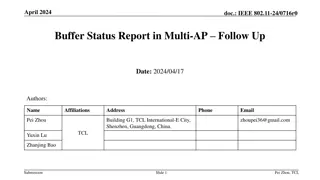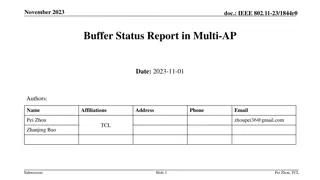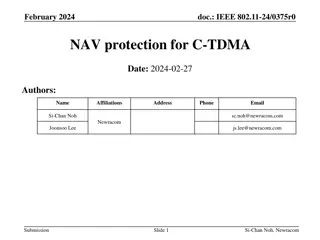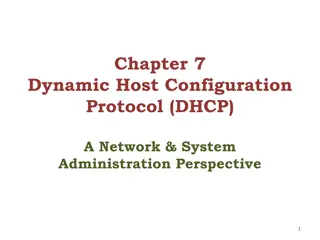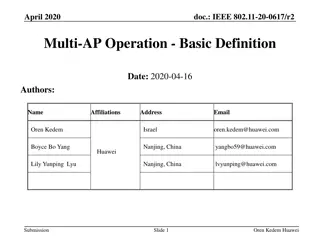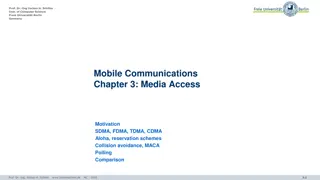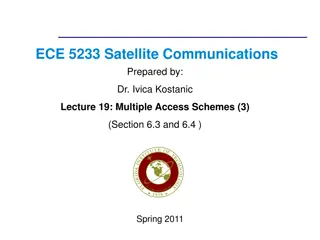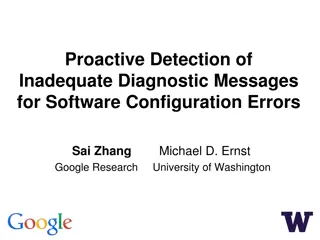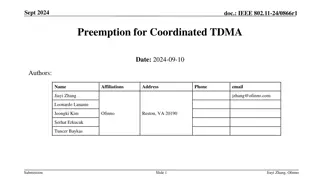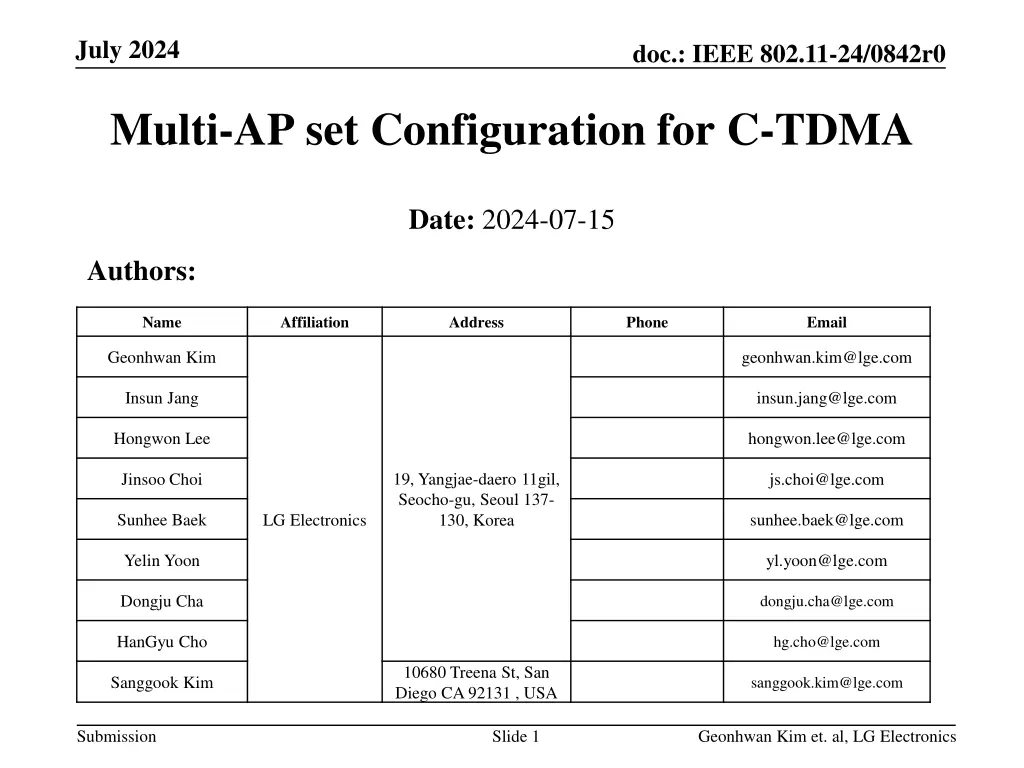
Configuring Multi-AP Set for C-TDMA in IEEE 802.11-24
Explore the detailed procedure for configuring Multi-AP sets, emphasizing C-TDMA and other MAPC schemes in IEEE 802.11-24. Learn about the negotiation process, AP coordination, and transmission methods for efficient Multi-AP operation.
Download Presentation

Please find below an Image/Link to download the presentation.
The content on the website is provided AS IS for your information and personal use only. It may not be sold, licensed, or shared on other websites without obtaining consent from the author. If you encounter any issues during the download, it is possible that the publisher has removed the file from their server.
You are allowed to download the files provided on this website for personal or commercial use, subject to the condition that they are used lawfully. All files are the property of their respective owners.
The content on the website is provided AS IS for your information and personal use only. It may not be sold, licensed, or shared on other websites without obtaining consent from the author.
E N D
Presentation Transcript
July 2024 doc.: IEEE 802.11-24/0842r0 Multi-AP set Configuration for C-TDMA Date: 2024-07-15 Authors: Name Affiliation Address Phone Email Geonhwan Kim geonhwan.kim@lge.com Insun Jang insun.jang@lge.com Hongwon Lee hongwon.lee@lge.com 19, Yangjae-daero 11gil, Seocho-gu, Seoul 137- 130, Korea Jinsoo Choi js.choi@lge.com Sunhee Baek sunhee.baek@lge.com LG Electronics Yelin Yoon yl.yoon@lge.com Dongju Cha dongju.cha@lge.com HanGyu Cho hg.cho@lge.com 10680 Treena St, San Diego CA 92131 , USA Sanggook Kim sanggook.kim@lge.com Submission Slide 1 Geonhwan Kim et. al, LG Electronics
July 2024 doc.: IEEE 802.11-24/0842r0 Introduction In our previous contribution, we introduced the overall C-TDMA procedure designed for Multi-AP coordination (MAPC) operation [1]. The overall procedure of C-TDMA may included (1) Multi-AP set configuration, (2) Multi- AP selection, (3) TXOP sharing, and (4) C-TDMA based transmission. Basically, Multi-AP set configuration means a negotiation process between neighboring APs to coordinate as an Multi-AP environment. For each AP to internally configure a Multi-AP set, it is necessary to exchange the information required to maintain MAPC or specific information for each MAPC scheme. i.e., this procedure may be commonly required for other MAPC schemes (e.g., C-SR/BF) [2]. In this contribution, we discuss in detail the Multi-AP set configuration procedure that focuses mainly on C-TDMA but also considers other MAPC schemes together. Submission Slide 2 Geonhwan Kim et. al, LG Electronics
July 2024 doc.: IEEE 802.11-24/0842r0 Recap: Overall C-TDMA Procedure [1] Multi-AP set configuration is required to initiate coordination between neighboring APs, and the negotiated information can be used and updated over a long period of time. After the Multi-AP set configuration, a Multi-AP set is configured locally for each AP. That is, each participating AP can create a Multi-AP coordination table/set (internally) including the successfully negotiated neighboring AP(s). The AP that obtains TXOP and initiates MAPC becomes a sharing AP (or coordinator AP). The coordinator AP can then announce to the potential shared AP(s) within the configured Multi-AP set about the initiation of MAPC. Coordination Announcement Finally, MAPC scheme (e.g., C-TDMA, C-SR, C-BF, ..) based transmission can be performed according to the MAPC scheme-specific sequences/methods (TBD). Submission Slide 3 Geonhwan Kim et. al, LG Electronics
July 2024 doc.: IEEE 802.11-24/0842r0 Discovery Basically, each AP may require MAPC in the following situations: Dense network or a lot of nearby APs A lot of associated STAs Requirements for burst traffic or periodic LL traffic An AP that wants to perform negotiations for MAPC can transmit a beacon frame indicating MAPC capabilities including information below: Multi-AP capability: Whether it supports Multi-AP coordination. Reserved bit located at the beginning of the beacon frame may be used (e.g., Capa. Infor., Ext. Capa.) Multi-AP scheme capability: Indicates what types of schemes are supported. e.g., use a bitmap to indicate the supported MAPC schemes (001: C-TDMA, 010: C-SR, ..). Therefore, an AP that receives beacon frame from its neighboring AP(s) capable of MAPC can decide to initiate a Multi-AP set configuration procedure [2, 3]. Also, some other information related to MAPC may be included in the beacon frame; AP may initiate negotiation by referencing this information, which may be included following MAPC related capabilities. Submission Slide 4 Geonhwan Kim et. al, LG Electronics
July 2024 doc.: IEEE 802.11-24/0842r0 Negotiation Based on the presence of neighboring AP(s) that has advertised the MAPC capabilities, the AP transmits a coordination/negotiation request frame to the corresponding AP. The neighboring AP responds to the sending AP with a coordination response frame. This frame may contain a Status Code or set some fields to the same or different values as the req. frame. To indicate Accept, set all values related to the MAPC to be the same except for parameters dependent on each AP. To indicate Reject, set all values related to the MAPC to a single value (e.g., all 0s or all 1s). When the AP receives a response frame containing a Reject or Recommendation, it can re-transmit the request frame to that AP or negotiate with another neighboring AP. Ultimately, the 2-way negotiation procedure is performed bidirectionally, and if both APs accept each other, the multi-AP negotiation between them can be considered successful. Submission Slide 5 Geonhwan Kim et. al, LG Electronics
July 2024 doc.: IEEE 802.11-24/0842r0 Contents in Multi-AP set Configuration During the negotiation procedure between APs, the req./resp. frame for MAPC operation may include the following information: Multi-AP ID: Each AP assigns an ID locally to distinguish one or more negotiated APs. The AP identifies negotiated APs by putting the Multi-AP ID in the AID12 field (e.g., 2047 4094 or 2008 2044). e.g., Set MSB to 1 and use 4 bits (16 APs) for Multi-AP ID. Multi-AP scheme capability (e.g., C-TDMA, C-SR, C-BF, ...). An AP, which has acquired the MAPC scheme capability of the neighboring AP through the beacon, may inform at least one of the MAPC scheme capability it supports. MAPC common operating parameters Information about BW (max. BW) or CH (PCH, overlapped CHs, punctured CHs) MAPC scheme-specific operating parameters For example, for measurement phase in C-SR/BF, the associated STA's ID, RF/MIMO capa., and buffer status may be included. Status code (in response frame) Accept Reject / Reject including recommendation Submission Slide 6 Geonhwan Kim et. al, LG Electronics
July 2024 doc.: IEEE 802.11-24/0842r0 Configuring a Multi-AP set (1/2) How to configure a Multi-AP set may be an implementation dependent. We provide an example of a Multi-AP set configuration for a unified MAPC that we assume. Assumptions for a Multi-AP set configuration are as follows: AP 1 and AP 4 support(or have a capability for) all types of MAPC schemes. AP 2 and AP 3 support only C-TDMA. AP 5 supports C-SR and C-BF. AP 6 supports only C-BF. Submission Slide 7 Geonhwan Kim et. al, LG Electronics
July 2024 doc.: IEEE 802.11-24/0842r0 Configuring a Multi-AP set (2/2) Multi-AP set configuration based on multiple MAPC schemes Each AP locally assigns a Multi-AP ID to negotiating APs and can deliver this ID during the negotiation procedure. Later, the Multi-AP ID is included in the AID12 field to identify negotiated APs. e.g., Put Multi-AP IDs in 2047 4094 or Put Multi-AP IDs in 2008 2044. Therefore, through the negotiation procedure, each AP participating in MAPC can internally create and manage the Multi-AP set. The figure shows an example of a Multi-AP set for APs 1, 4, and 6. When performing the sharing/coordinator AP s role, a Coordination Announcement procedure may be initiated for one or more APs belonging to the MAPC scheme subset in the Multi-AP set, depending on the intended MAPC scheme. e.g., AP 1 announces its intention for C- TDMA operation to members of the C- TDMA subset (AP 2, AP 3). Submission Slide 8 Geonhwan Kim et. al, LG Electronics
July 2024 doc.: IEEE 802.11-24/0842r0 Overall MAPC Procedure According to the Multi-AP set configuration, each AP has its own Multi-AP set. Based on this, AP 1 can coordinate with AP 2 or AP 3 using C-TDMA, or with AP 4 using C-SR. AP 4 can coordinate with AP 1 or AP 5 based on C-SR/BF, or with AP 1 or AP 3 based on C-TDMA. AP 1, which has obtained TXOP, asks the C-SR capable subset (i.e., AP 4) whether to participate in order to transmit based on C-SR. If the interference measurement phase is completed in advance and AP 4 sends a response frame during the coordination announcement phase, AP 1 can operate as a C-SR with AP 4. If AP 4 wants to operate as C-TDMA, it can announce its intention to AP 1 and AP 3. Based on the response frames, AP 4 allocates time to specific AP. Submission Slide 9 Geonhwan Kim et. al, LG Electronics
July 2024 doc.: IEEE 802.11-24/0842r0 Summary In this contribution, we introduced the details of the Multi-AP set configuration procedure for C-TDMA and other MAPC-based transmission. 1) Discovery: AP that receives beacon frame from its neighboring AP(s) can decide to initiate a Multi-AP set configuration procedure. 2) Negotiation: The AP transmits a coordination request frame to neighboring APs that have indicated MAPC capability. The receiving AP responds to the sending AP with a coordination response frame. The coordination req./resp. frame may include common information for MAPC and MAPC scheme-specific information. Finally, each AP locally configures a Multi-AP set based on one or more MAPC schemes, depending on its MAPC capabilities. Therefore, each AP can perform various Multi-AP coordination based transmissions using an individually configured Multi-AP set. Submission Slide 10 Geonhwan Kim et. al, LG Electronics
July 2024 doc.: IEEE 802.11-24/0842r0 References [1] 23/1912r1, Coordinated TDMA Procedure [2] 23/1871r2, M-AP Coordinated Transmission framework [3] 22/1895r0, Thoughts on M-AP Coordination Principles [4] 23/1917r0, Coordinated Spatial Reuse Submission Slide 11 Geonhwan Kim et. al, LG Electronics
July 2024 doc.: IEEE 802.11-24/0842r0 Straw Poll 1 Do you agree to add the following text to the TGbn SFD? An AP that intends to participate in multi-AP coordination with at least one AP can advertise its capabilities regarding multi-AP coordination via management frame. The detail of capabilities for multi-AP coordination is TBD. Management frame is TBD. Submission Slide 12 Geonhwan Kim et. al, LG Electronics
July 2024 doc.: IEEE 802.11-24/0842r0 Straw Poll 2 Do you agree to add the following text to the TGbn SFD? TGbn shall define a mechanism where an AP capable of multi-AP coordination can negotiate capabilities and operating parameters to agree on coordinated AP feature(s) with another AP capable of multi-AP coordination by exchanging individually addressed management frames. The detail of capabilities and operating parameters for multi-AP coordination is TBD. The individually addressed management frame is TBD. Submission Slide 13 Geonhwan Kim et. al, LG Electronics
July 2024 doc.: IEEE 802.11-24/0842r0 Straw Poll 3 Do you agree to add the following text to the TGbn SFD? During multi-AP coordination negotiation between APs, an AP that requests the negotiation assigns an ID to the corresponding AP. Details of ID is TBD. NOTE: As an example, the assigned ID is expected to be used in the AID12 field of the Trigger frame. Submission Slide 14 Geonhwan Kim et. al, LG Electronics


